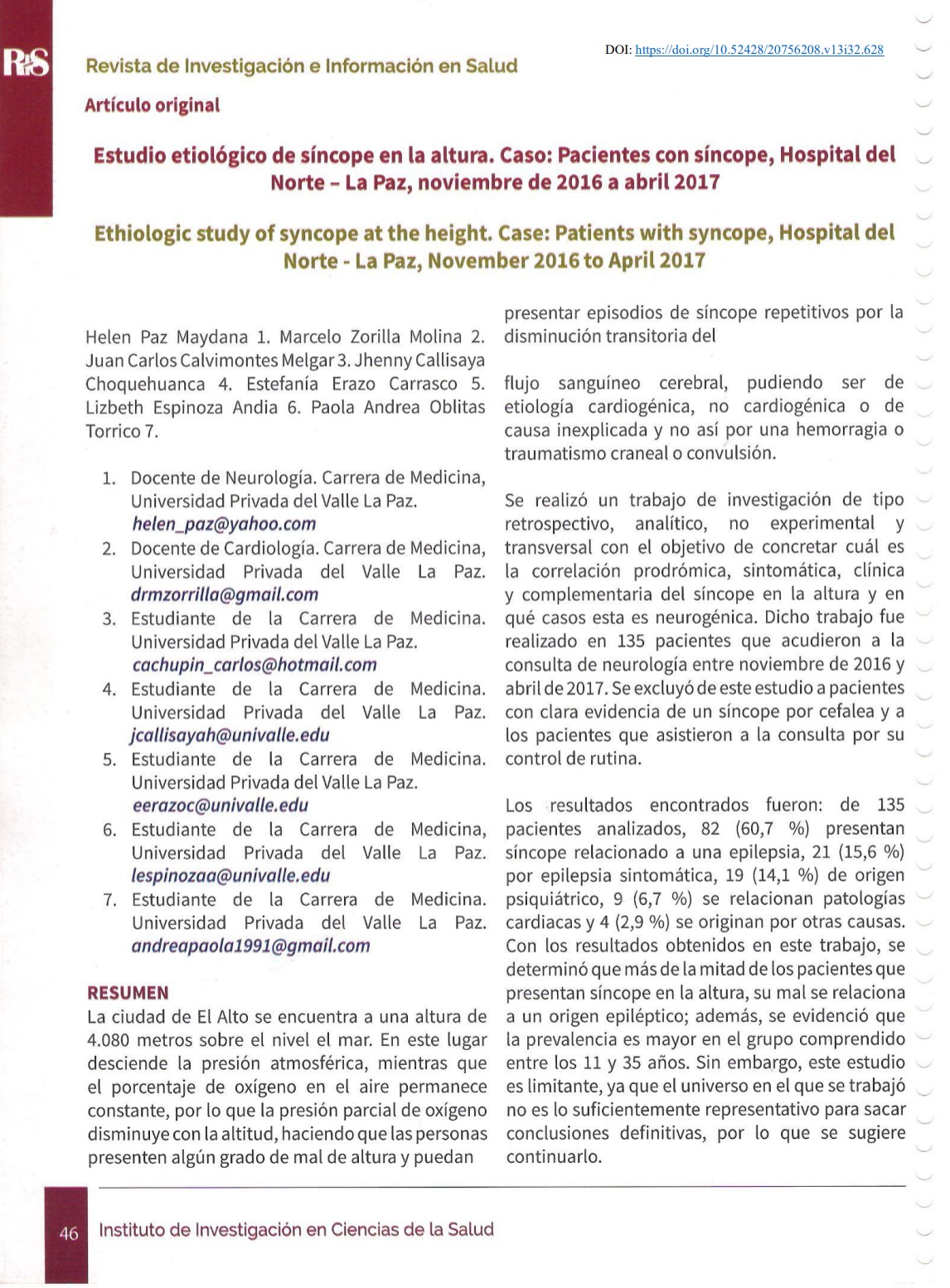Ethiologic study of syncope at the height. Case: Patients with syncope, Hospital del Norte - La Paz, November 2016 to April 2017
DOI:
https://doi.org/10.52428/20756208.v13i32.628Keywords:
Syncope, Emergency Medicine, Altitude sicknessAbstract
The city of El Alto is located at an altitude of 4,080 meters above the sea level. Place where atmospheric pressure decreases, while the percentage of oxygen in the air remains constant, so the partial pressure of oxygen decreases with altitude, causing people to present some degree of altitude sickness, and may present syncope episodes repetitive due to the transient decrease in cerebral blood flow, which may be of cardiogenic etiology, non-cardiogenic or of unexplained cause and not due to haemorrhage or head trauma or convulsion.
A retrospective, analytical, non-experimental, cross-sectional research was carried out to specify the prodromal, sym ptomatic, cli nical and complementary correlation of syncope in height and in which cases it is neurogenic. The research was conducted on 135 patients who attended to the neurology consu Itation from November 2016 to April 2017. Patients with clear evidence of a headache syncope and patients who attended the consultation due to their routine control were excluded from this study.
The results found were: of 135 patients analyzed, 82 (60,7 %) presented syncope related to an epilepsy, 21 (15,6 %) due to symptomatic epilepsy, 19 (14,1 %) of psychiatric origin, 9 (6,7 %) are related cardiac pathologies and 4 (2,9 %) are caused by other causes. With the results obtained in this study, it was determined that more than half ofthe patients who present syncope in the height, is related to an epileptic origin, in addition it shows that the prevalence is higher in the age group of 11 to 35 years. However, this study is limiting, since the universe in which it was worked is not sufficiently representative for draw definitive conclusions, and it is suggested to continue it.
Downloads
References
HAMPEL K, JAHANBEKAM A, ELGER C y SURGES R. Seizure - related modulation of Systemic arterial blood pressure in focal epilepsy. 2016; Epilepsia, USA, 57: 1709-1718.
XU Y, NGUYEN D y MOHAMED A. Frequency of a false positive diagnosis of epilepsy: A systematic riview of observational studies. 2016; Seizure, Australia, 41: 167 - 174.
SHMUELY S, VAN DER LENDE M y LAMBERTS RJ. The heart of epilepsy: Current views and future concepts; 2017, Seizure, The Netherlands, 44: 176-183.
PIPPA E, ZACHARAKI El, KOUTROUMANIDIS M. Data fusion for paroxysmal events classification from EEG; Journal of Neuroscience Methods. 2017; France, 275: Pages 55-65.
KOUTROLOU P, SINGH A y LEEMAN M. Syncope, seizure or both? 2016; Acute cardiac care, USA, 18: 31-34.

Downloads
Published
How to Cite
Issue
Section
License
Copyright (c) 2018 Helen Paz Maydana , Marcelo Zorilla Molina , Juan Carlos Calvimontes Melgar , Jhenny Callisaya Choquehuanca , Estefanía Erazo Carrasco, Lizbeth Espinoza Andia y Paola Andrea Oblitas Torrico

This work is licensed under a Creative Commons Attribution 4.0 International License.
Authors who publish with this journal agree to the following terms:
- Authors retain copyright and grant the journal right of first publication with the work simultaneously licensed under a Creative Commons Attribution License 4.0 that allows others to share the work with an acknowledgement of the work's authorship and initial publication in this journal.
- Authors are able to enter into separate, additional contractual arrangements for the non-exclusive distribution of the journal's published version of the work (e.g., post it to an institutional repository or publish it in a book), with an acknowledgement of its initial publication in this journal.
- Authors are permitted and encouraged to post their work online (e.g., in institutional repositories or on their website) prior to and during the submission process, as it can lead to productive exchanges, as well as earlier and greater citation of published work.






















